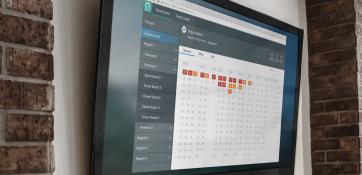A leader at Schneider became concerned when a driver sounded fatigued and irritable during a routine check-in call. Using Trucking Fatigue Meter™, along with other safety management methods to investigate the issue, the leader identified the root cause and worked with the driver to help him reduce fatigue while keeping his weekly hours up.

Challenges
Improve collaboration between driver leaders and drivers to identify and mitigate fatigue causal factors.
Educate drivers about the benefits of developing a consistent sleep and work routine.
Help drivers reach their pay target while reducing the risk of fatigue-related issues.
Products and services
"When Fatigue Meter is used along with other safety management methods, fatigue awareness is enhanced within our management team and with our drivers."
Nick Economu, CDS
Safety and Training Manager,
South Van Truckload – TX Divisions
A leader at Schneider became concerned when a driver sounded fatigued and irritable during a routine check-in call. Using Trucking Fatigue Meter™, along with other safety management methods to investigate the issue, the leader identified the root cause and worked with the driver to help him reduce fatigue while keeping his weekly hours up.
Solution
The leader noticed that the driver was working an inconsistent work schedule. Depending on the loads and availability, the driver would start some days in the morning at 0800, other days at noon, and on some occasions even started late into the evening at 1800 or 2200. When drivers change from one shift to another like this, it’s hard to establish a consistent sleep pattern, which can potentially cause fatigue-related issues.
The leader called the driver to discuss his work pattern. The driver expressed his concern that if he stayed on a consistent work schedule, his pay would be negatively impacted. It was explained by the leader that a consistent work schedule would manage fatigue levels and improve work performance. The driver and the leader discussed alternative work schedules, and although the driver was skeptical, he agreed to try out a consistent night schedule for one week, followed by a consistent daytime schedule the next week.
After the two-week trial run, the driver reached his pay target both weeks and decided to stick with the consistent nighttime shift. In a follow-up conversation, he expressed how much more rested and alert he felt behind the wheel after switching to a regular schedule. He said it clicked for him how developing a consistent sleep and work routine and managing fatigue can positively affect his overall well-being.
“This is a great example of how collaborating with drivers to manage fatigue can go a long way toward creating a safe and productive work environment. A fleet’s drivers are invaluable to its success, and it is just good business to help them be healthy and fit for duty,” said Daniel Mollicone, CEO, Pulsar Informatics, Inc.

